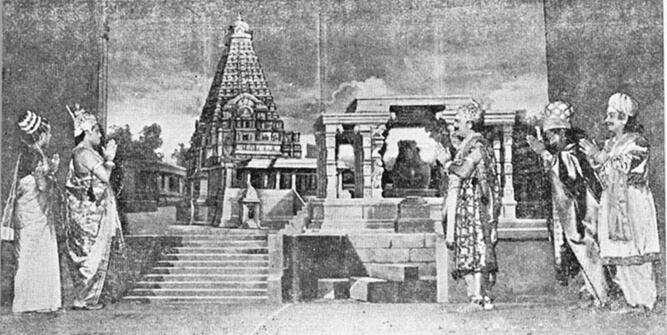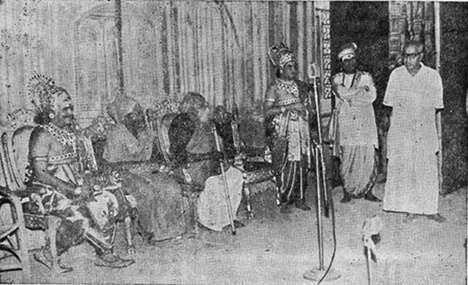Registered with the Registrar of Newspapers for India under R.N.I 53640/91
Vol. XXX No. 1, April16-30, 2020
Rajaraja Cholan, Prior to Sivaji Ganesan
by Karthik Bhatt
Long before the Chola monarch Rajaraja Chola was accused of land grab by a film director, he was the subject of one of Tamil theatre’s most successful stage plays by the T.K.S. Nataka Sabha. This article is a brief recount of the making of the play.
 A scene from the play.
A scene from the play.Following the success of the first Tamil drama Conference in Erode in 1944 (MM, September 16-30, 2019), the TKS Brothers came up with a scheme that was the first of its kind, that of a competition for playwrights. In his memoirs Enadhu Nataka Vaazhkai, T.K. Shanmugam writes that the idea came about thanks to the fact that while there existed awards for short stories, essays and other forms of literature, there was no reward to promote script writing. After detailed discussion with his brothers, a scheme was drawn up to implement the idea. It was decided that a sum of Rs 1,000 be instituted as award, with the first prize winning Rs. 600 and the second prize winning Rs. 400.
The details of the scheme were announced by a press release dated December 1, 1944. Foremost amongst the rules was that the works had to be original ones based on either social or historical themes, with translations not being allowed. The scripts had to be capable of being dramatised into plays of three hours duration, with the TKS Nataka Sabha retaining the rights to stage them with or without modifications. A deadline of June 1, 1945 was announced for the entries, with the prizes being announced on September 1st. T.K. Shanmugam also writes that on the subject of choosing the judges for the competition, a discussion with a few friends in the literary circle did not bring about any consensus and hence it was decided that the brothers themselves would act as judges.
The scheme came in for praise from several magazines such as Naradar, Kumaran, Hanuman, Kalaivani etc. The brothers wrote personal letters to writers they knew, inviting entries. In all, around 300 writers were contacted. The first script was received just a month after the scheme was announced, after which entries started coming in periodically. A total of 59 scripts were received at the end of the stipulated period, out of which 10 were shortlisted. Aval Vibachariyaa by L. Sethuraman of Aravankurichi won the first prize, while the second prize was won by twenty-year old Aru.Ramanathan for his play Rajaraja Cholan.
Born in Kandanur in July 1924, Aru. Ramanathan had passed his Intermediate Examination from the Pachaiyappa’s College in Madras, before giving up his college education in order to pursue his dream of becoming a writer. In 1947, he started a monthly magazine called Kadhal in Trichy, marking his first full-fledged venture in the world of literature. His first play Vanavil on the theme of social and economic equality came out in 1948. He also wrote several short stories such as Pazhayanur Neeli, Nayanam Sundaravadivu, Ambikapathi and Manoranjitham. He is however best remembered today for his magnum opus Veerapandian Manaivi based on the power struggles between the Pandya and Chola kingdoms in the 12th Century. It was serialised over a period of six years in his magazine.
The plot of Rajaraja Cholhan revolved around the relationship between Vimaladityan (Vimaladitya), the Eastern Chalukya King and Rajaraja Chola. Vimaladityan ascends the throne after vanquishing Sathyasirian (Sathyashraya) thanks to Rajaraja Chola’s support. He is in love with the Chola emperor’s daughter, princess Kundavi. Baladeva, an accomplice of Sathyashraya with an eye on the Chola kingdom serves as the political advisor to Rajaraja Chola. He then engineers a misunderstanding between Vimaladitya and Rajaraja Chola, leading to a declaration of war between them. How Rajaraja Chola manages to overcome the challenge and Kundavi and Vimaladityan finally unite forms the rest of the story.
The T.K.S. Nataka Sabha inaugurated Rajaraja Cholan in 1955. While the cast of the play had the regulars of the troupe, a perusal of a booklet containing the songs and press reviews of the play reveals several legends in the field of arts who were associated with the play. The songs were written by Puthaneri R Subramaniam, the well-known poet and playwright and a close associate of T.K. Shanmugam. They were set to tune by M.K. Athmanathan, an integral part of the T.K.S. Nataka Sabha who was also involved with S.V. Sahasranamam’s Seva Stage. A sadly underrated composer, Athmanathan was also a very successful lyricist who wrote the lyrics for several famous film songs such as Vinnodum Mugilodum for the film Pudhaiyal, Azhagu Nilaavin Bhavaniyile for the film Maheshwari and Engey Selvaayo for the film Rathapaasam. A sequence in the play featured the dance arangetram of princess Kundavi at the Peruvudaiyar temple after its grand consecration, for which the choreography was by the legendary Guru Vazhuvur Ramaiyya Pillai.
The art work for the play was by V. Madhavan Pillai. A graduate of the School of Arts at Trivandrum, he had joined Jagannatha Iyer’s Madurai Bala Meena Ranjani Sangeetha Sabha in the 1920s as an assistant to his teacher Velayudhachari, who had been contracted by the troupe for its artwork. He later joined Nawab Rajamanickam’s Madurai Devi Bala Vinoda Sangeetha Sabha and worked for several years, before going on to be associated with the Sakthi Nataka Sabha. He started the Shanti Studio in Royapettah, which was famous amongst the artists of Tamil Nadu and Kerala. He later came to be associated with the legendary Kalanilayam Krishnan Nair and was involved in several of Kalanilayam’s productions such as Sri Guruvayoorappan and Kadamattathu Kathanar.
With such a strong crew assisting the cast, the play was a resounding success and received lavish praise from the press. It was staged over 2,000 times in India and in places like Malaysia and Singapore. In 1973, the play was made into a movie with Sivaji Ganesan playing the title role. It was the first cinemascope in Tamil cinema and was produced by G. Umapathy, proprietor of Anand Theatre. Actor and film historian Mohan Raman recalls that the public used to offer quick prayers while crossing Vasu Studios, where the sets of the Brihadeeswara Temple were erected for the shooting!
 Kunnakudi Adigalar, Periyar and Sir P.T. Rajan at the Rajaraja Cholan play.
Kunnakudi Adigalar, Periyar and Sir P.T. Rajan at the Rajaraja Cholan play.
